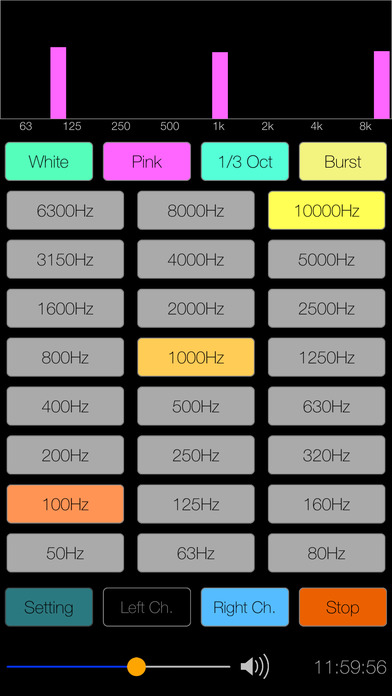
Octave Band Noise Generator app for iPhone and iPad
”Octave Band Noise Generator" is a new noise generation tool that can be used to as the best sound source for a variety of acoustic measurement and auditory effects.
Octave band noise can be used for various purposes as a reference sound source for environmental sound measurement, sound tuning, tinnitus relief and sound masking.
It can generate the specific noise signal for the sound check to be used for general acoustic measurement.
As a great feature, it is possible to programmably produce a specific octave band noise signal by using bandpass filtering of 1/1 or 1/3 octave band with ideal steep attenuation characteristics.
You can use it as a reference sound source in accordance with the environmental sound measurements in the room acoustic and the construction sites as follows:
- Sound insulation level measurement.
- Indoor sound field distribution measurement.
- Reverberation time measurement.
Octave band noise can be created as a multi-band coupling signal by 1/1 octave band filter with a center frequency from 63Hz to 8kHz or 1/3 octave band filter with a center frequency from 50Hz to 10kHz.
As other applications, Octave band noise is also useful to adjust the characteristics of the audibility of earphones or headphones.
For example, by selecting the pink noise and playing the 1/1 octave band noise in the order of 125Hz, 1KHz, 8kHz of the center frequency, you can determine the intensity of each frequency band on the audibility. For more detail analyzing, please try in other octave bands or 1/3 octave noise.
If you know the characteristic of frequency band, you will be able to adjust the earphone in the equalizer to your favorite sound easily.
Features:
- Generation of White Noise, Pink Noise and Brown Noise (Seed Noise) : 20Kz - 20kHz.
- 1/1 Octave Band Noise : 8 types, center frequency - 63Hz, 125Hz, 250Hz, 500Hz, 1kHz, 2kHz, 4kHz, 8kHz.
- 1/3 Octave Band Noise : 24 types, center frequency - 50Hz, 63Hz, 80Hz, 100Hz, 125Hz, 160Hz, 200Hz, 250Hz, 320Hz, 400Hz, 500Hz, 630Hz, 800Hz, 1kHz, 1.25kHz, 1.6kHz, 2kHz, 2.5kHz, 3.15kHz, 4kHz, 5kHz, 6.3kHz, 8kHz, 10kHz.
- Octave band noise can be selected multiple bands simultaneously. So this combined signal contains the frequency components of the multi-band.
- Burst function : Sound On/Off generation cycle - 1, 2, 5, 10 seconds.
- Output channel selection : L / R / L&R.
- Timer function : 1 min - 23 hours 59 minutes, as units 1 minute.
Note :
For processes of testing and equalizing rooms and auditoriums, it is convenient to have broadband noise signals. Typically, white noise or pink noise is used. In order to further measure in detail, Octave band noise will be able to take advantage of the testing noise signal that some part of the 1/1 or 1/3 octave band is divided.
- White noise
White noise is noise whose amplitude is constant throughout the audible frequency range. Twice the power corresponds to a 3 decibel increase, so white noise is said to increase 3 dB per octave in power.
- Pink noise
Pink noise is filtered to give equal power per octave or equal power per 1/3 octave. The power of pink noise per Hz of bandwidth decreases by 3 decibels per octave. When pink noise is chosen for equalizing auditoriums, the real-time analyzer can be set up so that they display a straight horizontal line when they receive pink noise.
- Brown noise
Brown noise is noise signal that has been filtered in order to generate a lot of energy at low frequencies. The power of brown noise per Hz of bandwidth decreases by 6 decibels per octave.
- Octave band noise
Octave band noise is generated the multiple frequency divided band signal by using the band-pass filtering of 1/1 or 1/3 octave band. It can be used in order to measure and evaluate the sound level of a certain frequency band on the basis of the octave. This signal contains all the characteristics of the source signal of seed noise in the divided frequency band.



